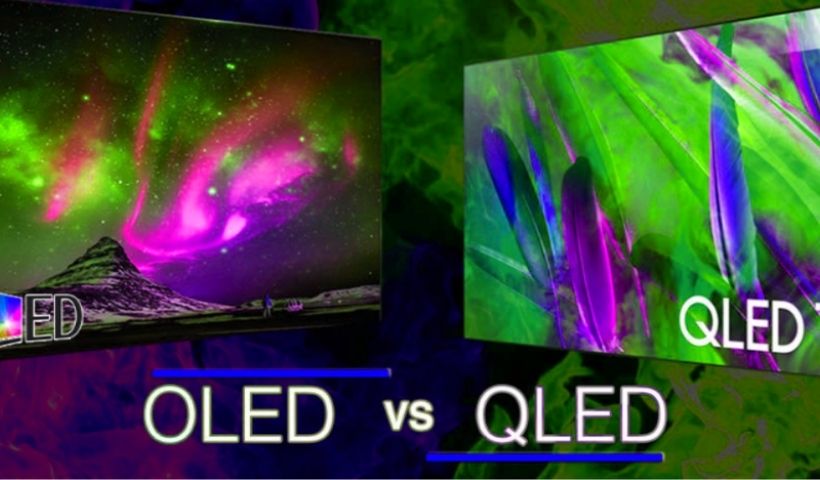What Are The Differences Between OLED And QLED Televisions?

The two technologies are relatively new, but more and more devices use them, although it is true that the problem with both is that being so new, they are quite expensive and in most cases -especially in terms of TV- they are only fit for lucky pockets.
In any case, we are going to first see what each of them consists of and then we are going to buy the main parameters of them to discern which of the two technologies is better today.
OLED (LG, Panasonic and Sony) and QLED (Samsung) are two television technologies with quite a few differences. In this article we explain how these two types of televisions differ.
Table of Contents
What Does OLED Mean?
- OLED stands for Organic Light Emitting Diode , which can be translated as organic light emitting diode . A diode is an electronic device, and the term organic refers to the light from the screen being generated (emitted) by organic molecules – they contain carbon !
What Does QLED Mean?
- QLED stands for quantum dot LED TV , according to Samsung, the brand that created this technology. We can translate it as LED television with quantum dot technology,
- The image is created as it has always been created on LCD screens, and what quantum dot technology does is enhance color and brightness.
What Is The Main Difference Between OLED And QLED TVs?
- Although they have a very similar name, OLED and QLED televisions are very different.
- The main difference is that QLEDs are LCD televisions , the typology with the largest market share now, while OLEDs are not LCD televisions.
Also Read : What Are Startup Tips To Start A New Business?
A QLED Is An LCD Television
- As we said, a QLED belongs to the family of the Teles LED LCD. In fact, it is a specific and high-end type of LCD LED television, which has quantum dot technology as its main differential feature.
- Like all LCD televisions, QLEDs require a backlight panel . The differences in quality are given by the way that lighting is implemented.
- QLED is a transmissive technology , as it relies on a light that comes from the back of the screen.
An OLED Has Pixels That Emit Their Own Light
- OLED TVs are a totally different technology category. They lack a rear lighting panel. In contrast to LCDs, each pixel in an OLED can generate its own light. One of the great things about that is that an OLED can turn off pixels and get absolutely perfect blacks.
- OLED is an emissive technology (pixels emit light directly).
Blacks And Contrast
- Contrast is the difference between the brightest white and the darkest black that a screen can display. For many, this parameter is key to providing perfect image quality
- OLED screens can turn off their pixels (the light disappears completely), so, in theory, the contrast ratio is infinite.
- OLED: deep blacks ideal for watching TV in a low-light space
- It is an ideal technology for a home space where natural light can be easily dimmed, where you can watch a movie or football game relatively in the dark. In those low ambient light conditions, deep blacks are much more important than a super-bright image.
- If a television is capable of delivering true black, you do not need to exaggerate the brightness to ensure a certain level of contrast.
QLED: Best Dark Grays
- Nobody is perfect, so OLED displays falter a bit with dark grays, when the pixels are no longer off.
- LED displays like QLED, on the other hand, offer better dark grays, but their blacks are not as authentic. LED manufacturers have tried to solve this with local dimming , a technology that can create a halo effect on parts of the image that it enhances.
Brightness: QLEDs Shine Brighter
- OLED screens are great for watching TV in the dark, but they don’t have the same level of brightness as an LED LCD. OLED pixels are organic (they contain carbon), so they fade over time. To compensate for this tendency to age prematurely, manufacturers have to limit pixel brightness to a reasonable level.
- This is why QLED displays (and LED LCDs in general) can be much brighter than OLEDs. If the room has a lot of light, you won’t get as much out of OLED.
- OLED displays are bright enough for most people. However, if you are looking for brightness, what you need is an LED panel.
- Response time: OLEDs are faster
- The response time of a screen is the time it takes for pixels to change from one color to another. QLED televisions have a response range of 2 to 8 milliseconds , while OLEDs can be as fast as 0.1 milliseconds .
- Therefore, OLEDs are much faster, which is of interest to gaming enthusiasts who want to use the TV as a screen for their games.
Also Read : What Are The Keys To Invest In The Stock Market Profitable?






